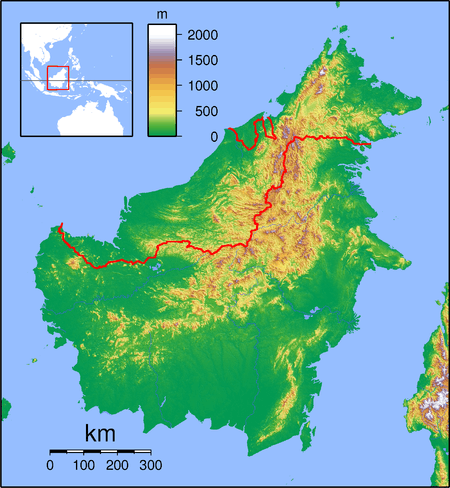Semporna
| Semporna | ||
|---|---|---|
| District and Town | ||
|
Semporna Waterfront. | ||
| ||
 | ||
 Semporna | ||
| Coordinates: 4°29′0″N 118°37′0″E / 4.48333°N 118.61667°E | ||
| Country |
| |
| State |
| |
| Division | Tawau | |
| Population (2010) | ||
| • Total | 133,164 | |
| Website | www.sabah.gov.my/md.sprn www.sabah.gov.my/pd.sprn | |
Semporna is a district as well as town located in Tawau Division, in the east coast of Sabah, Malaysia on the island of Borneo. Its population was estimated to be around 133,164 in 2010.[1]
History

Semporna was founded soon after the British North Borneo Chartered Company established Sandakan, and initially settled by Chinese traders, most fleeing from Spanish attack on the Sulu Sultanate. Before been named as "Semporna", this area are known as "Tong Talun" in Bajau language which means "Hujung Hutan" in Malay or "At the end of the forest" in English language.[2] Those who responsible for this naming was Panglima Uddang, Panglima Sallehangni and Panglima Sakti from the Bajaus Kubang ancestry.[2] Soon, the name been slowly changed to "Semporna" (known as "Peaceful Place") which later became the permanent name for this place.[2]
Including other parts of eastern Sabah, this area are once been ruled by the Sultanate of Sulu before been handed to the British North Borneo Chartered Company in 1876 through an agreement.[2] Since that, the Sultan has handed this area for forever under the administration of the British.[2] Other western powers including the Dutch have tried to conquer this area in June 1876 but failed as the British have already establishing a present here.[2]


This area also became the main landing point for the Pirates.[2] Very few people lived on the coasts with the reason was not far to seek.[2] Fierce pirates and marauders infested the seas, kidnapping, raiding and killing from time immemorial.[2] Action by Sir James Brooke, and other nearby westerners powers such as the Dutch and Spanish authorities earlier in the century had managed to reduce the power and range of the pirates.[2] Upon the advent of the Chartered Company in the early 1880s, only one pirate stronghold remained, which at Omadal island, and this was cut out and cauterised by HMS Zephyr of the British in 1886.[2]
By mid 1887, an opportune moment had arrived for the opening of a trading station on the southern side of the entrance to Darvel Bay.[2] Pirates having recently destroyed the settlement of Maimbung in Sulu, some of the Chinese merchants there, had asked permission to settle in the Company's territory, under the rule of law and its attendant advantages.[2]
Geography

Semporna is located at the tip of Semporna Peninsula around Lahad Datu Bay (also known as Darvel Bay), and is visited by tourists as a base for scuba diving or snorkelling trips to Pulau Sipadan (Sipadan Island), some 36 kilometres southeast of town.
Demographics
_Pictures.jpg)
The majority of the population is Bajau, many of whom live in sprawling stilt villages over the water on the outskirts of town. Thousands of Bajau Laut (also known as Sea Gypsies or Pala'u) people live on the sea around Semporna. They are one of the few nomadic sea borne peoples of the world, and spend most of their lives on boats, finding a livelihood from the coral reefs in the area. For some Bajau Laut people, the only time that their bodies spend a long time on land is when they are buried after death.
The main ethnic minority populations in Semporna are the Kadazan and Chinese communities. The majority of Chinese people in Semporna are from the Hakka dialect group.
Religion
Islam is the largest religion with 85% of the citizens are Muslim, followed by Christian with 12.45% while Buddha became the smallest one with 1%.
Languages
Sabahan Malay creole is the lingua franca in Semporna. Semporna is also home to the only Zamboangueño Chavacano-speaking community in Malaysia. Semporna's Chavacano speakers are refugees (or descendants of refugees) who fled the Moro conflict in the Philippines. A large number of these refugees live in Malaysia illegally.
Economy
Marine products are still the mainstay of the local economy, as well as tourism. Pearl culturing is a major component of this industry.
Tourism

Semporna is also known for the Regatta Lepa traditional boat races which occur annually in April. Semporna was also the location of the finish line of Eco-Challenge: Borneo, held in 2000. Off the coast is a marine park called Tun Sakaran Marine Park also known as Semporna Islands Park. It was gazetted by Sabah Parks in 2004.
Semporna is the gateway to diving paradise in world-renowned islands like Sipadan, Mabul, Kapalai, Mataking, Sibuan, Mantabuan, Siamil and Pom Pom among others. Visitors to Semporna are mainly sun seekers looking to relax or to take up water sports activities such as scuba diving or snorkelling.
Cuisine
As Semporna is a coastal town, visitors are encouraged to try out all the various fresh seafood as they are cheap and delicious.
References
External links
| Wikimedia Commons has media related to Semporna. |
-
 Semporna travel guide from Wikivoyage
Semporna travel guide from Wikivoyage - (Malay) Semporna District Council
- (Malay) Semporna District Office
Coordinates: 4°29′N 118°37′E / 4.483°N 118.617°E

